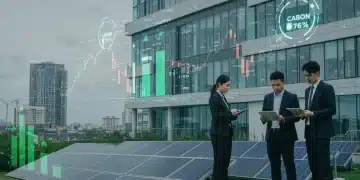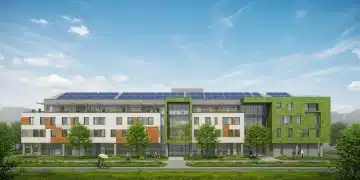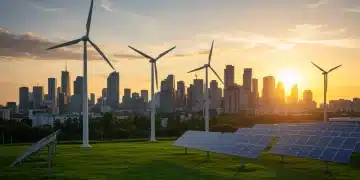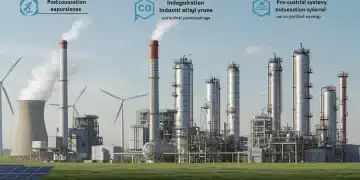Green Building Materials: 2025 Guide to Emissions Reduction
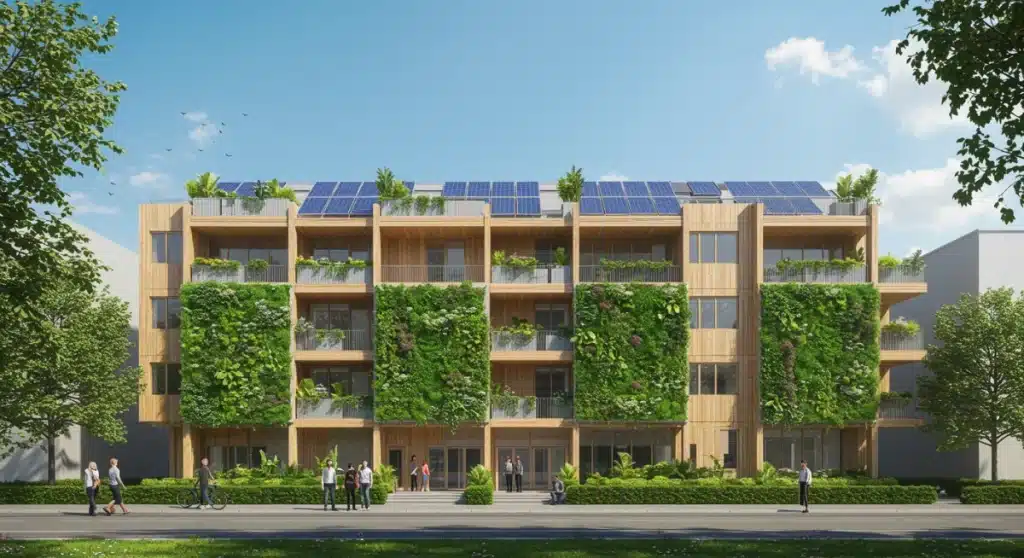
A 2025 guide to green building materials outlines critical strategies for reducing U.S. construction emissions by 18%, emphasizing sustainable practices and innovative material adoption across the industry.
The construction sector is bracing for a transformative shift, as a new guide aims to redefine industry standards. This comprehensive Green Building Materials: A 2025 Guide to Reducing Construction Emissions by 18% in the U.S. is now available, outlining crucial steps to mitigate environmental impact.
The Urgency for Sustainable Construction
The imperative to reduce carbon emissions within the construction industry has never been more pressing. As of early 2024, the sector remains a significant contributor to global greenhouse gas output, driven largely by material production and transportation. The new 2025 guide acts as a critical roadmap for the U.S. to achieve an ambitious 18% reduction in construction-related emissions, pushing for immediate adoption of more sustainable practices.
Industry leaders and environmental advocates are increasingly converging on the necessity of this shift. The guide emphasizes not just compliance, but a proactive embrace of innovation to meet these targets. It signals a major pivot from traditional methods to a future built on ecological responsibility and resource efficiency, impacting every stage of a building’s lifecycle.
Understanding Embodied Carbon
Embodied carbon, the emissions associated with material extraction, manufacturing, transportation, and construction, represents a substantial portion of a building’s total carbon footprint. The 2025 guide places a strong emphasis on addressing this often-overlooked aspect.
- Material Sourcing: Prioritizing locally sourced and recycled content.
- Manufacturing Processes: Advocating for low-energy production methods.
- Transportation Logistics: Optimizing supply chains to minimize fuel consumption.
Key Green Building Materials for 2025
The guide highlights several categories of green building materials poised to lead the charge in emissions reduction. These materials offer alternatives to conventional options, providing both environmental benefits and often improved performance characteristics. Their adoption is central to meeting the 2025 targets.
From structural components to interior finishes, developers and architects are now tasked with evaluating and integrating these innovations. The focus is on materials that not only reduce embodied carbon but also contribute to healthier indoor environments and long-term building resilience. This includes a broad spectrum of products, each with unique advantages.
Innovative Material Categories
Several material types are gaining prominence due to their low environmental impact and high performance. These are expected to become standard practice in new construction.
- Recycled Content Materials: Such as recycled steel, concrete, and plastics, significantly reducing demand for virgin resources.
- Bio-based Materials: Including bamboo, mass timber (CLT), straw bales, and hempcrete, which sequester carbon and are renewable.
- Low-Carbon Concrete: Innovations like geopolymer concrete and carbon-cured concrete are drastically cutting down cement’s carbon footprint.
- Advanced Insulation: Materials like recycled denim, sheep’s wool, and aerogel offer superior thermal performance with lower environmental impact.
Strategies for Implementation and Adoption
Achieving an 18% emissions reduction by 2025 requires more than just identifying green materials; it demands robust implementation strategies. The guide outlines critical pathways for the widespread adoption of these materials, focusing on policy, incentives, and industry collaboration.
Successful integration depends on breaking down existing barriers, including cost perceptions and lack of familiarity. Educational programs, demonstration projects, and clear performance metrics are essential to accelerate the transition. The industry is being called upon to work collectively, fostering an ecosystem where sustainable choices are both accessible and economically viable.
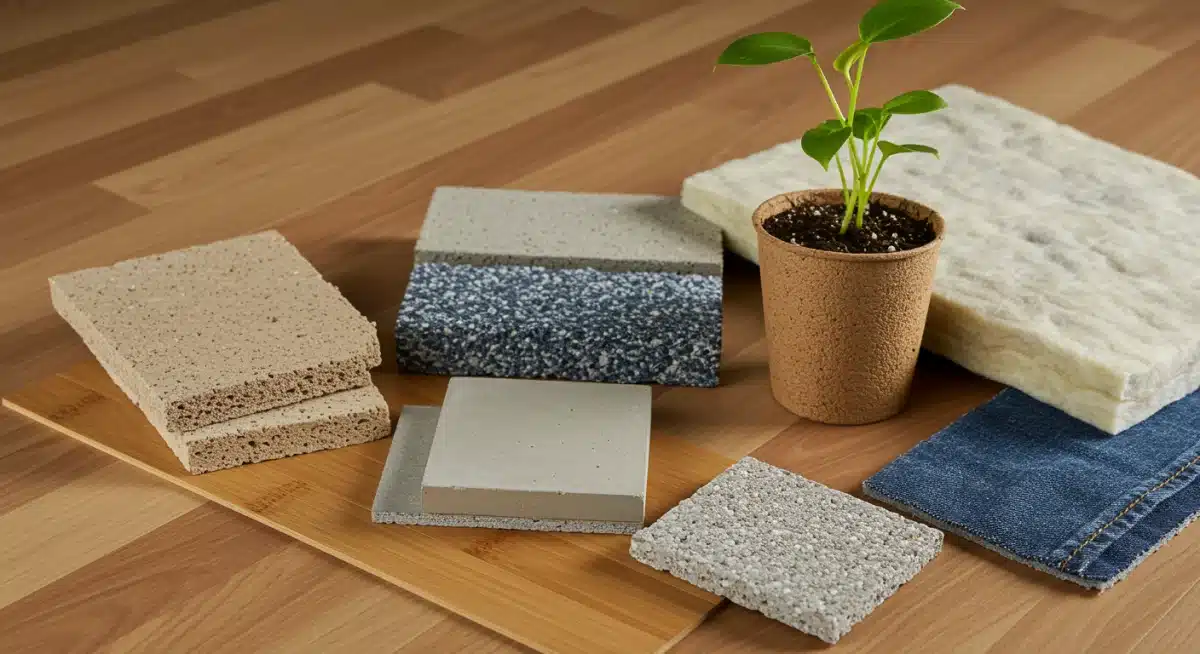
Driving Change Through Policy and Incentives
Government policies and financial incentives are crucial for catalyzing the shift towards green building materials. These measures aim to make sustainable options more competitive and attractive.
- Tax Credits and Rebates: Encouraging the use of certified green materials and construction methods.
- Green Building Codes: Mandating minimum standards for embodied carbon and material sustainability in new projects.
- Public Procurement Policies: Prioritizing green materials in government-funded construction, setting a market example.
Overcoming Challenges in Green Material Adoption
While the benefits of green building materials are clear, their widespread adoption faces several challenges. These include initial cost concerns, limited supply chains for certain specialized materials, and a need for greater education among constructors and designers. Addressing these hurdles is paramount for the 2025 targets.
The guide provides actionable insights for navigating these obstacles, suggesting strategies for cost-benefit analysis that considers long-term operational savings and environmental impact. It also calls for investment in research and development to scale up production and diversify the availability of sustainable options across the U.S. market.
Addressing Common Hurdles
Successful integration of green materials requires proactive solutions to common industry challenges. These include:
- Perceived Higher Costs: Highlighting long-term savings from energy efficiency and reduced maintenance.
- Supply Chain Limitations: Investing in domestic production and fostering regional material networks.
- Lack of Awareness/Education: Developing robust training programs for architects, engineers, and contractors.
- Performance Data Gaps: Promoting transparent data sharing and certification for green materials.
Economic and Environmental Benefits
The transition to green building materials offers a dual advantage, delivering significant economic benefits alongside crucial environmental ones. Beyond reducing emissions, these materials can lead to lower operational costs, enhanced building value, and new job creation within the green economy.
From an environmental perspective, the benefits extend beyond carbon reduction to include improved air and water quality, reduced waste, and conservation of natural resources. This holistic approach underscores the long-term sustainability and resilience that green construction brings to communities and the planet.
Measuring Impact and Return
Quantifying the benefits is essential for demonstrating the value of green materials. The guide emphasizes metrics that capture both financial and ecological returns.
- Reduced Energy Consumption: Lower utility bills due to superior insulation and material performance.
- Waste Diversion: Less landfill waste from construction and demolition activities.
- Improved Health and Productivity: Healthier indoor air quality benefiting occupants.
- Enhanced Brand Reputation: Companies adopting green practices often gain a competitive edge and attract environmentally conscious clients.
The Role of Certification and Standards
Certification programs and industry standards are vital tools for ensuring the credibility and performance of green building materials. These frameworks provide a reliable way for designers, builders, and consumers to identify products that meet specific environmental criteria. The 2025 guide strongly advocates for their expanded use.
Standards like LEED, Living Building Challenge, and Cradle to Cradle certification offer transparent benchmarks for material sustainability. They help streamline the selection process and build confidence in the environmental claims of products. Their role in driving market demand for truly green options cannot be overstated.
Navigating Green Certifications
Understanding the various certification bodies and their criteria is key for effective material selection. These certifications provide independent verification of environmental performance.
- LEED (Leadership in Energy and Environmental Design): Recognizes buildings with high environmental performance across multiple categories.
- Cradle to Cradle Certified: Assesses products for material health, recyclability, renewable energy use, water stewardship, and social fairness.
- Environmental Product Declarations (EPDs): Provide transparent, verified information about the environmental impact of products over their life cycle.
| Key Point | Brief Description |
|---|---|
| 2025 Emissions Target | U.S. construction aims to reduce emissions by 18% through green materials and practices. |
| Key Material Focus | Emphasis on recycled content, bio-based materials, and low-carbon concrete. |
| Implementation Strategies | Policy, incentives, and industry collaboration are critical for widespread adoption. |
| Benefits Beyond Emissions | Economic savings, improved indoor health, and enhanced building value. |
Frequently Asked Questions About Green Building Materials
The main goal is to reduce U.S. construction emissions by 18% by the year 2025. This is to be achieved through the widespread adoption of green building materials and sustainable construction practices, impacting all stages of a building’s lifecycle.
Key types include recycled content materials like steel and concrete, bio-based options such as mass timber and hempcrete, low-carbon concrete innovations, and advanced insulations like recycled denim. These materials offer reduced environmental impact.
Achievement relies on a multi-faceted approach including government policies, financial incentives like tax credits, updated green building codes, and public procurement policies favoring sustainable materials. Industry collaboration and education are also vital.
Beyond environmental gains, green materials lead to lower operational costs due to energy efficiency, increased building value, and reduced waste. They also foster innovation and job creation within the growing green economy sector.
Certifications like LEED and Cradle to Cradle provide critical benchmarks for material sustainability and performance. They offer transparency and build confidence, helping stakeholders identify and select products that meet stringent environmental criteria.
Looking Ahead
The release of the 2025 guide marks a pivotal moment for the U.S. construction industry. What happens next will largely depend on the swift and coordinated response from stakeholders across the sector. Expect to see increased pressure for compliance and innovation, particularly as federal and state governments begin to align procurement and regulatory frameworks with these new targets. This initiative is not merely about meeting a numerical goal; it’s about fundamentally reshaping how America builds, driving a more sustainable and resilient future. Watch for early adopters and policy amendments as the guide’s influence begins to manifest in real-world projects.
